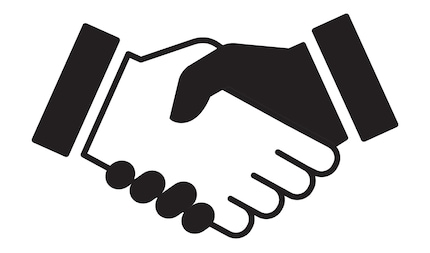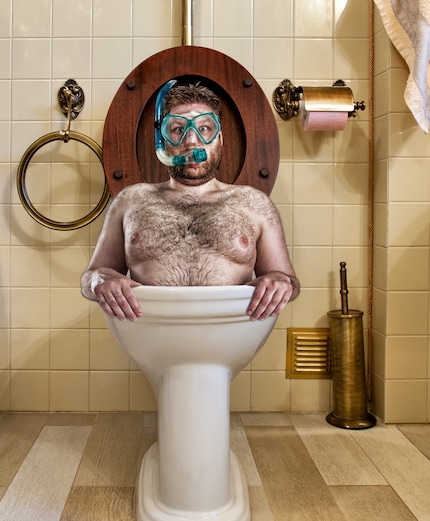
The stick up the arse of photography
Stock photos are at best boring and at worst so artificial that they physically hurt. Why is that? Why does it never get better? And why are stock photos still so widespread? I try to fathom the essence of this strange genre of photography.
Beautiful and happy people sit at a table and hold a meeting. Someone in a light blue shirt points somewhere where there is nothing to see. The others are looking into space with great interest. The people all look very clean, almost sterile, and form a politically correct mix of men and women, old and young, light and dark-skinned.
What I am describing is not a specific image, but a type of image: symbolic photos that illustrate office work. There are countless of them. And they are one thing above all: interchangeable.

These images look unnatural. This is not even necessarily because the models are bad actors. The deeper reason is that these photos show a world that doesn't exist. Let me briefly explain what I mean by that.
Icon images are the rice cakes among the photos
Photos are expressive when they show something very special. Usually something very specific. When they capture the mood, the emotions of a unique moment. This feeling of "Only right now, only right here, then never again!" The more pronounced this is, the stronger the effect of the photo: moments for eternity. This happens at major sporting events, for example. I will never forget the expression on footballer Toto Scillaci's face at the 1990 World Cup. Scillaci was one of many footballers before and after the World Cup. The World Cup in his own country was his big moment. He scored six goals, became top scorer and best player of the tournament. When he celebrated, he always looked like a little boy who couldn't believe his luck.

Stock photos are exactly the opposite of a unique moment. They should be universal. That's why they show as little concrete information as possible. Stock photos have more in common with pictograms (at the railway station or airport) or with very large icons on the computer than with an ordinary photo.


Stock photos are symbolic images. They are easy to digest, but don't reveal anything. So like rice cakes. Typical for stock photos is that you forget them immediately. They are not memorable. That's why we see the exact same image over and over again without noticing it.

From a purely commercial point of view, this must be the case. This is because stock photos are created for a purpose that is not even clear at the time of creation. What's more, they are created to be usable for as many things as possible at the same time. That is why they are so general, so vague. They show a bit of everything and nothing.
Stockfish doesn't just sound similar to stockfish, it is stockfish.
Stockfish is fish that has been preserved by drying. The heads and guts of the fish are removed before drying. Stockfish was originally a «poor man's food», as cod was caught in sufficient quantities. With stockfish, the fish are tied together in pairs by the tail fins and hung on wooden racks (norw. stokk) to dry.
Stockfish is inexpensive fish in stock. Stock photos are inexpensive photos in stock. Something essential has been removed from both things.
Who needs such images?
Stock photos are usually somewhere between free and quite cheap, available immediately and you can choose from a wide range of images. The sometimes complicated field of licence rights is clearly regulated from the outset: You know what you are allowed to use the image for and under what conditions. These conditions are often very loose: buy once, use unlimited.
But the question still arises: why don't companies, for example, take photos of their work themselves? Today, you don't need insanely expensive equipment to do this, and you can usually find someone with photographic flair who would do it cheaply. We on the digitec editorial team do this in our articles, and we think it's nice if the photos aren't perfect and you can see the mess on our desks. Including coop bag.
But not everyone is so open. Many employees don't want to be photographed, and that's their right. They don't want the mess on their desk to be seen, not to mention post-its with passwords or embarrassing desktop backgrounds. Authentic photos always reveal something that is not intended. With stock photos, meticulous care is taken to ensure that this is not the case. That's why they look so sterile.
The mentality that nothing tangible should get out is unfortunately very common in corporate communications. The stock photos therefore also reflect the uptight communication in today's office world: "Thank you for your feedback. We will be happy to get back to you at a later date. Please do not reply to this email." Or: "We are happy to confirm your 2nd reminder from 30 May", or "As soon as our Head of Blablubber has approved the key points, we will roll out a certified report in the next agile sprint". To be as intangible as possible, to be as unaccountable as possible - bureaucracy has a stick up its arse. For many "communication experts", stock photos are therefore exactly what they need.
Journalism also has a great need for stock images, because newspapers don't always have material from the actual event. Nevertheless, a picture is needed because it attracts more attention than a desert of lead and because it provides a quick introduction to the topic. However, under the general pressure to save money, the media not only invest too little in photographers and reporters on location, but also too little time and brainpower in the meaningful use of symbolic images. Media critic Stefan Niggemeier has documented particularly stupid examples over a long period of time. Have fun!

Avoiding clichés creates new clichés
But couldn't stock photos be done better? Create images that aren't clichéd? That offer some variety? Of course, many people are trying to do this; the stock photo platform EyeEm, for example, has a good reputation in this regard. There are also many photos in other image databases that look more modern and less worn out.
However, new clichés are created in a short space of time. Whether office work is symbolised by a secretary in a deux piece or by the same 28-year-old hipster with a full beard, it doesn't change the fact that they are clichés. In the hip start-up, the desks are made of wood, the shirts are colourfully checked and the walls are unplastered. Clichés. Even a different colour scheme can't change that. Today, warm light with orange tones dominate; ten or twenty years ago, bluish colours were still the trend in the business world. Either way: everything looks the same.

Warm backlight: check. Beard: check. Plaid coloured shirt: check. Wooden table: check. All clichés fulfilled, clean!

Beard: Check. Checkered colourful shirt: Check. Flooded with light: check. Unplastered walls: check. Solid untreated wooden table: Fail! There's still room for improvement!
That's exactly the problem with hipsters: they try to be unconventional, but all in the same way, which creates a new convention. Even the politically correct mixes of men, women, young, old, light and dark originally aimed to break stereotypes. Business people should not always be portrayed as white 50-year-old men. A good intention, but it ultimately seems artificial, and the constant repetition doesn't make it any better.
Drunken in the flood of images
Stock photography is a business with the masses. On the one hand, this applies to photographers who have to upload a large number of images to generate an income. Photographer Marco Herndorff, for example, has set himself a target of 2000 photos per year. The output of the photographers is channelled into online databases that have to manage gigantic inventories. And this is becoming more and more extreme.
The online platforms are now practically fully automated. There is hardly any manual sorting and indexing. That would be too expensive and too slow. This also means that there is hardly any quality control. Only completely identical photos (automatically recognisable) are rejected, but not photos that are very similar to others and therefore offer no added value. To avoid becoming completely invisible in this flood of similar photos, photographers have to upload even more images. A vicious circle.
The abyss of stock photography
Of course, the photographers could also be original. But I assume that they are saving their really good images for other purposes, because there is very little to be gained from a single image on the stock photo platform. Especially not with a special image, because it has a limited purpose. That's why: If someone tries to be original or even funny in stock photography, then you have to be prepared for the worst.
I found these two examples of failed originality in the space of two minutes. There are tonnes of them.


Some stock photo phenomena have become well-known memes. For example, the white-haired man with the strange facial expression. Although his smile looks very pained, there are countless photos of him in all kinds of scenes. "Hide the pain Harold" has picked up on the hype surrounding his persona and opened its own YouTube channel.
In stock photography, real people are abstracted into symbols. Here, the process is reversed, so to speak, and a circle is closed. The symbol becomes a real person again. The meme Harold becomes what he actually is: András Arató from Hungary, a retired engineer who at some point resigned himself to becoming a joke on the internet and is now trying to make the best of it. And suddenly everything is very different from the world of stock photos. We have an insight into a person's life, concrete, unique. And we remember it later.
My interest in IT and writing landed me in tech journalism early on (2000). I want to know how we can use technology without being used. Outside of the office, I’m a keen musician who makes up for lacking talent with excessive enthusiasm.
Interesting facts about products, behind-the-scenes looks at manufacturers and deep-dives on interesting people.
Show all